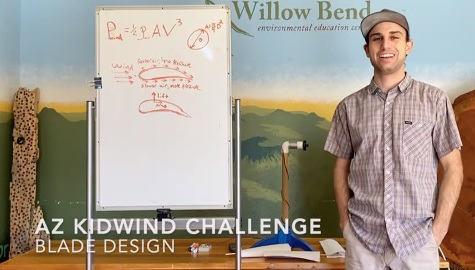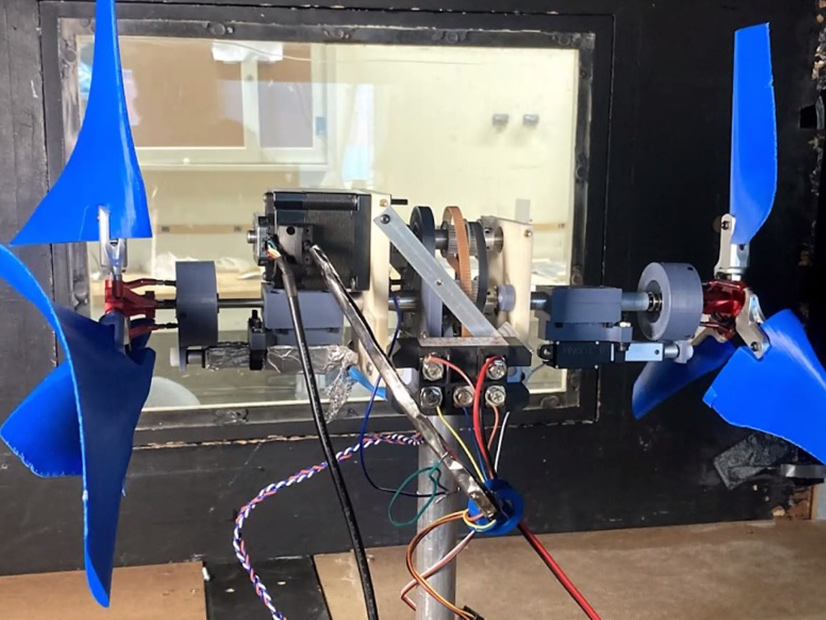Judging began in the U.S. Department of Energy’s Collegiate Wind Competition on Wednesday with virtual team presentations.
Students from Johns Hopkins University (JHU) launched the competition with a look at their search for wind turbine efficiency via a counter-rotating dual-rotor design. They entered the design in the Turbine Prototype contest, which includes an optional testing phase that is not part of judging.
“This turbine design combines two separate turbine rotors to harvest energy from the weight of the rotors,” JHU team member Annika Torp said. Theoretically, the dual rotors can be 25% more efficient than a comparable single-axis wind turbine, and the team set out to see if they could achieve that result.
Doing so meant bringing the team together virtually in the early part of the pandemic for the design phase, and building a prototype when students were allowed to work in person again.
“All of our validation testing was performed in our one-meter wind tunnel on campus and in a benchtop setting for electronics,” Torp said. “Basically, what we found in testing was similar to what we had predicted [for efficiency].”
Last year, students were asked to “research, design and build a turbine for deployment in highly uncertain times, with a great degree of unknown risk and delays.”
“The 2021 competition embodied this challenge, as the teams adapted to the uncertainties and the hurdles of attending school and preparing for competition during the pandemic,” DOE Acting Assistant Secretary Kelly Speakes-Backman said at the start of judging.
Thirteen teams are competing in three contests and vying for first, second and third place overall. In addition to the Turbine Prototype contest, the competition includes Project Development for a 100-MW wind farm and Connection Creation, which is new this year.
Connection Creation called for teams to conduct outreach and build connections with wind industry members as well as local communities and media.
Judging continues through next week and culminates in an awards ceremony on June 11.
Team NAU
Students from Northern Arizona University (NAU) kicked off presentations on Wednesday in the Project Development and Connection Creation contests.
The team developed a wind farm site plan in South Dakota with 70 wind turbines on property that contains an existing 230-kV transmission. They chose the Siemens-Gamesa 5.8-155 (6.6 MW) wind turbine from a manufacturing facility in a neighboring state.
“We chose this turbine because its high hub heights will capture higher wind speeds, and the higher capacity size of the turbine was chosen to produce high amounts of power, while needing less turbine sites and reducing overall project costs,” NAU team member Natalie McDonald said.
They were able to model the project with an installed capacity of 98.6 MW and capacity factor of 42% generating 368 GWh of energy annually. In addition, the team determined that the project would be economically viable based on a levelized cost of energy of $0.057/kWh and a levelized power purchase agreement price of $0.06/kWh.
As part of the NAU team’s submission for the Connection Creation contest, they developed an outreach plan that included supporting the Arizona KidWind Challenge and working with Willow Bend, a local environmental education center.
“The Arizona KidWind Challenge is a micro-scale wind turbine competition for kids … that is very similar to the [Collegiate Wind Competition] but is less competition-based and more for the sake of learning hands-on how the turbines work and how you can make them more efficient,” NAU team member Aaron Zeek said.
To accommodate social distancing guidelines, the team created instructional videos for the KidWind Challenge, with the help of Willow Bend, instead of providing in-classroom instruction. One of the videos showed kids how to maximize the power of a wind turbine through blade design.
At the end of the challenge, the team contributed to judging.
“It was amazing to see what the students created,” McDonald said. “The winning teams will be moving forward to compete in the National KidWind Challenge.”
Competition Teams
Collegiate team presentations will continue June 7, 8 and 10.
The 13 participating teams are:
- Brigham Young University
- California State University Maritime Academy
- California Polytechnic State University
- Johns Hopkins University
- James Madison University
- Kansas State University
- Northern Arizona University
- Pennsylvania State University
- Texas Tech University
- University of Maryland
- University of Wisconsin-Madison
- Virginia Tech University
- Washington State University-Everett
Learn-along teams are a new feature of the competition this year. They submit projects and receive feedback but are not eligible for awards. The two learn-along teams are University of Colorado Boulder and University of Wyoming.


